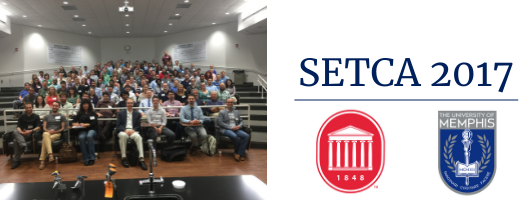Location
Coulter Hall, Room 211
Start Date
19-5-2017 10:20 AM
Description
A cornerstone of the development of novel quantum chemistry methods is the translation of paper-and-pencil theory into an efficient computer program. To do this, low-level programming languages are typically employed; however, such implementations tend to be convoluted, as raw speed is the focus rather than either readability or reproducibil-ity. Any attempt at re-implementation must then proceed with the originally published equations as the only reference, whereby critical programming details must be re-discovered through a similarly heroic effort to the original implementation. To address these issues, the Psi4NumPy project [1] leverages the Psi4 quantum chemistry package and the Nu-merical Python (NumPy)library to create an interactive quantum chemistry programming environment for reference implementations, rapid development, and education. This envi-ronment allows for quantum chemistry-specific quantities computed with Psi4 and strided tensor manipulations performed with NumPy to be called directly from within the high-level Python programming language. Therefore, implementations of novel methods may be devel-oped quickly and programmed concisely, while maintaining a relatively low execution time. Provided as a series of short Python scripts, reference implementations for a variety of pop-ular quantum chemistry methods (including Hartree–Fock, Møller–Plesset, coupled cluster, electron propagator, and symmetry-adapted perturbation theories) address the community need for clear, readable programs which disseminate the details of such methods’ implemen-tation. Additionally, interactive tutorials discussing both the theory and implementation of these methods and others offer a unique educational framework for novice and experienced quantum chemists alike.
- Daniel G. A. Smith, Georgia Institute of Technology
- Dominic A. Sirianni, Georgia Institute of Technology
- Lori A. Burns, Georgia Institute of Technology
- Konrad Patkowski, Auburn University
- C. David Sherrill, Georgia Institute of Technology
Relational Format
Conference proceeding
Recommended Citation
Sirianni, Dominic A., "CL2. Psi4NumPy: An Interactive Quantum Chemistry Programming Environment for Reference Implementation, Rapid Development, and Education" (2017). Southeast Theoretical Chemistry Association Meeting (SETCA). 8.
https://egrove.olemiss.edu/setca/2017/schedule/8
CL2. Psi4NumPy: An Interactive Quantum Chemistry Programming Environment for Reference Implementation, Rapid Development, and Education
Coulter Hall, Room 211
A cornerstone of the development of novel quantum chemistry methods is the translation of paper-and-pencil theory into an efficient computer program. To do this, low-level programming languages are typically employed; however, such implementations tend to be convoluted, as raw speed is the focus rather than either readability or reproducibil-ity. Any attempt at re-implementation must then proceed with the originally published equations as the only reference, whereby critical programming details must be re-discovered through a similarly heroic effort to the original implementation. To address these issues, the Psi4NumPy project [1] leverages the Psi4 quantum chemistry package and the Nu-merical Python (NumPy)library to create an interactive quantum chemistry programming environment for reference implementations, rapid development, and education. This envi-ronment allows for quantum chemistry-specific quantities computed with Psi4 and strided tensor manipulations performed with NumPy to be called directly from within the high-level Python programming language. Therefore, implementations of novel methods may be devel-oped quickly and programmed concisely, while maintaining a relatively low execution time. Provided as a series of short Python scripts, reference implementations for a variety of pop-ular quantum chemistry methods (including Hartree–Fock, Møller–Plesset, coupled cluster, electron propagator, and symmetry-adapted perturbation theories) address the community need for clear, readable programs which disseminate the details of such methods’ implemen-tation. Additionally, interactive tutorials discussing both the theory and implementation of these methods and others offer a unique educational framework for novice and experienced quantum chemists alike.
- Daniel G. A. Smith, Georgia Institute of Technology
- Dominic A. Sirianni, Georgia Institute of Technology
- Lori A. Burns, Georgia Institute of Technology
- Konrad Patkowski, Auburn University
- C. David Sherrill, Georgia Institute of Technology



Comments
Download includes an expanded abstract with collaborators, institutional affiliations and cited references.